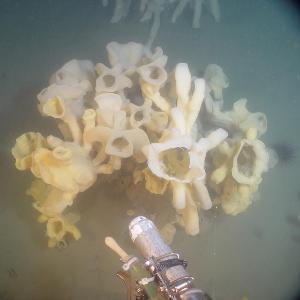Glass sponge genome furnishes insights into evolution of biomineralization
21 Jun 2023
The genome of a glass sponge species suggests that silica skeletons evolved independently in several groups of sponges.
21 Jun 2023
The genome of a glass sponge species suggests that silica skeletons evolved independently in several groups of sponges.

The reef-building glass sponge Aphrocallistes vastus is found off the coast of British Columbia in Canada. | © Sally Leys and CSSF ROPOS
Researchers led by geobiologist Professor Gert Wörheide have decoded the genome of Aphrocallistes vastus, a reef-building glass sponge found off the coast of British Columbia. The sponge possesses a unique skeletal structure of amorphous silicon dioxide, from which the class of glass sponges gets its technical name – Hexactinellida. Well-annotated and contiguous genomes are an indispensable resource for understanding the evolution, development, and metabolic capacities of organisms. However, the ecologically important sponges are underrepresented with respect to available genome resources.
As the researchers report in the journal Royal Society Open Science, the sponge species possesses a compact genome with numerous nested genes. The study identified several genes connected with the growth of the animals, and in particular with the formation of their mineral skeleton. Its results suggest that the biomineralization of silicon dioxide developed independently in different sponge classes. “Our investigations shed a new light on the biology of glass sponges, provide valuable insights into their evolutionary history, and highlight their ecological significance, deepening our understanding of these mysterious organisms and their important role in marine ecosystems,” says Wörheide.
Warren R. Francis, Michael Eitel, Sergio Vargas, Catalina A. Garcia-Escudero, Nicola Conci, Fabian Deister, Jasmine L. Mah, Nadège Guiglielmoni, Stefan Krebs, Helmut Blum, Sally P. Leys, Gert Wörheide: The genome of the reefbuilding glass sponge Aphrocallistes vastus provides insights into silica biomineralization. Royal Society Open Science, 2023